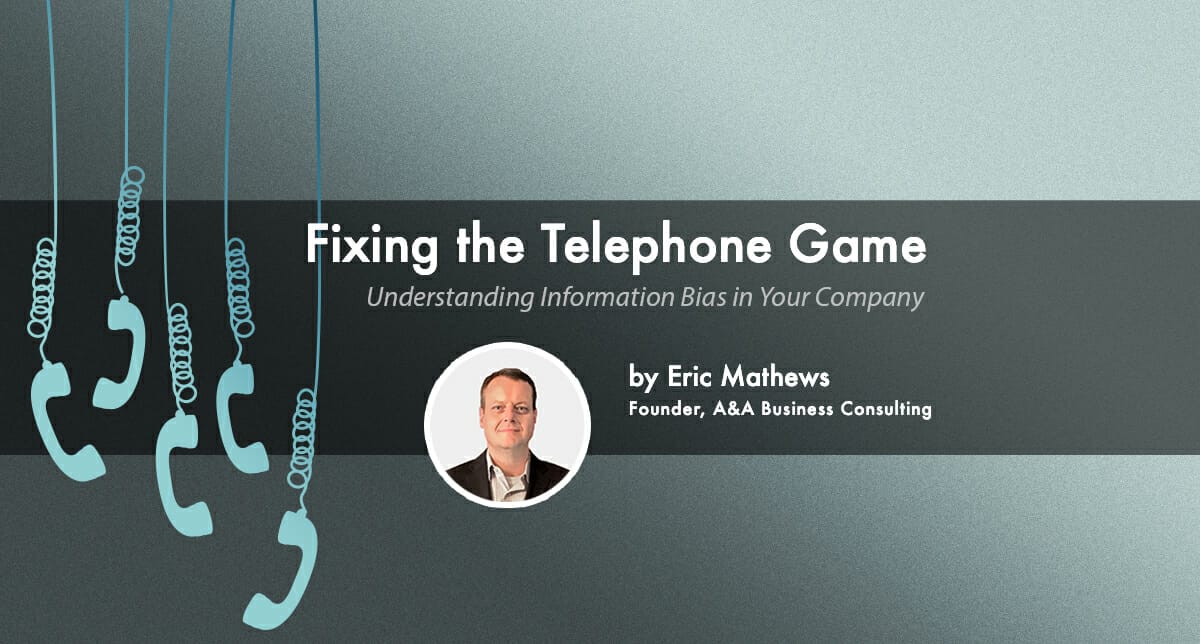Understanding Information Bias in Your Company
Have you ever watched an episode of Undercover Boss? I’m sure you’ve wondered what going “undercover” for a day in your own company would reveal – I know I have. When you lead complex organizations, it can become difficult to have a sense of what’s “really going on” on the front lines.
Remember the Telephone Game from when you were a kid? Where you’d whisper a phrase to your neighbor and then they’d pass it along? It’s always funny as the last person in line repeats what they’ve heard because of the enormous departure from the original phrase.
The thing is, internal business communications suffer from this problem every single day. Trust me when I say that it isn’t funny when miscommunications and misrepresentations come across your desk as fact.
So, of course, leaders would relish a chance to secretly serve on the front lines of their organization. However, without TV magic, seeing things as they really are can feel practically impossible. This is one of many reasons you have managers and supervisors helping you maintain a sense of what goes on, empowering you to lead well.
But what if that game of telephone went both directions? Unfortunately, it does.
It’s easy to see that reports from the front lines that reach you could skew one way or another. It often works the other way, too. This is the nature of working with many teams, layers, systems, departments, and functions. A communication to your team of managers, then communicated to their teams, can change dramatically, impacting the actions taken on the front lines.
In my last post, we discussed the role of fear in decision making, but there’s another challenge: what if the information flowing to you and from you, is corrupted along the way? How can you lead boldly if you’re never quite sure if your message flows down as intended, or that unbiased information is coming back up? It seems obvious to me that great leadership requires accurate information.
BIAS & THE BROKEN TELEPHONE
The reality is that each layer of your organization will insert their own degree of bias. Like everyone, each employee has developed a particular bias from their time in their position. They have formed a lens by which they see every situation, and interpret all communications. These biases can include disdain for a specific employee or department, a preference for specific systems, or even culture and leadership expectations based on the actions of your predecessor.
Now, could an employee outright lie about a situation to manipulate outcomes? Sure, but they’d be looking for a new job before long. Instead, the misinformation borne of layers of bias distorts information without a single culprit to take the blame, and misinformation often leads to bad leadership decisions.
You probably have a trustworthy staff, but that does not in any way discount the fact that bias influences communication. It takes just one well-meaning supervisor, overly loyal to a problematic employee, to derail operations.
Remember that the layers built into your business are there for a good reason, but hierarchical systems have their shortcomings, such as increasing the influence of bias in communications.
REDUCING THE ROLE OF BIAS
If you want to make better business decisions, you’ll want to circumvent bias and establish systems that help you combat its’ effects. Naturally, while we are working with a client, our on-site consultants provide an almost surgical free-flow of information as we help to resolve the challenges at hand. This provides an excellent, short-term way to exponentially decrease the role of bias as we work to find the most effective solution to a problem. There are also two practices to combat bias that we encourage in hierarchical organizations that you can easily implement.
One simple practice with a low barrier of entry would be to host multi-level conference calls at a large scale. This is relatively easy to do. It may seem simple, but employees at the “bottom” of an organization often report enjoying these calls most. The call gives them the opportunity to hear directly from leadership without filters! With everyone on the same call, upper levels are empowered to reflect on the questions being asked, helping them to adjust communications to reflect the needs of those above and below them.
We also often recommend another easily implemented practice known as “Skip Level Meetings.” The principle behind Skip Level Meeting is simple: encourage a member of management to participate in meetings several levels “beneath” them. As you can imagine, you’ll gain a much more robust sense of what’s going on at different levels of your organization while combating bias in communications on multiple fronts. It could even be as simple as asking your management team to add one meeting per quarter to their calendar.
So, while you may not swing your own episode of Undercover Boss, you don’t have to let that stop you from getting to the truth in your business. You can stop playing Broken Telephone. You can get better information, enabling you to make better decisions! With our help, or by implementing any of the practices above, you’ll be well on your way to knowing and using the truth to help you improve the bottom line.
Of course, if you’d like help doing any of the above, I’d love to speak with you about how we can help you get there.





